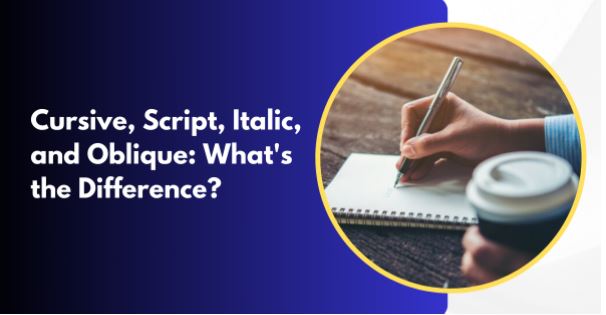
Cursive, Script, Italic, and Oblique: What’s the Difference?
In the realm of writing, various styles have emerged over centuries, each with its unique attraction and purpose. Understanding the differences between cursive, script, italic, and oblique is crucial for appreciating the art of written communication, as it allows for the appreciation of various styles. In the world of fonts and typography, terms like “cursive,” “script,” “italic,” and “oblique” are often thrown around interchangeably. While they all share a connection to handwriting, they have distinct characteristics and applications. Let’s discover the differences between these four commonly confused terms.
Cursive Writing:

Cursive writing is a style of penmanship in which the letters are joined together in a flowing, continuous stroke. In print writing, on the other hand, each letter is formed independently and is not connected to its neighbors.
It originated in ancient Rome and became the dominant writing form in Western Europe during the Middle Ages and Renaissance. The 20th century saw a decline in the use of cursive writing due to the advent of typewriters and computers.
Today, cursive writing is still taught in some schools, but it is not as widely used as it once was. Nevertheless, there are still many benefits to learning the cursive alphabet, including:
- Improved writing skills: cursive writing requires more precise hand movements than print writing, which can help to improve writing skills.
- Faster writing speed: Cursive writing is often faster than print writing, as the pen does not need to be lifted off the paper as often.
- Improved cognitive skills: Some studies have shown that learning cursive writing can help to improve cognitive skills, such as memory and attention.
- Enhanced creativity: Cursive writing can be a more expressive form of writing than print writing, which can help to enhance creativity.
- Better understanding of history: Cursive writing has been the dominant form of writing for centuries, and learning it can help to provide a better understanding of history.
Script Writing

Scriptwriting, often referred to as screenwriting, is the art and craft of writing stories specifically for visual media, like movies and television shows. It involves crafting a narrative that unfolds through dialogue, action, and camera angles.
Think of it as a blueprint for a film. It outlines the entire story, from the beginning to the end, including the characters, dialogue, plot points, and setting. It serves as a guide for everyone involved in the production process, including the director, actors, cinematographer, and crew.
Here are some benefits of learning script writing:
- Improved storytelling skills: Scriptwriting can help you develop your storytelling skills, which can be beneficial in many different areas of your life.
- Creativity: Scriptwriting is a creative outlet that allows you to express yourself and your ideas.
- Career opportunities: If you are interested in working in the film or television industry, learning script writing can give you a valuable skill set.
- Enjoyment: Scriptwriting can be a lot of fun! It is a great way to let your imagination run wild and create something that can be enjoyed by others.
Italic Writing
Italic writing, also known as Italic script or chancery hand, is a style of handwriting characterized by a slanted rightward tilt, connected letters, and flowing strokes. It emerged during the Renaissance in Italy, developed by the humanist scholar and scribe Niccolò Niccoli. He sought to revive the ancient Roman script, finding it more aesthetically pleasing and legible than the Gothic script is prevalent at the time.
Italic writing is characterized by a slanted rightward tilt, connected letters, rounded letterforms, and emphasis on vertical strokes. It is popular for calligraphy due to its elegance and legibility and is also used for everyday writing. Italic writing is also taught in schools to improve fine motor skills, hand-eye coordination, and creativity. It is also used in calligraphy for formal documents.
Here are some benefits of learning Italic writing:
- Improved fine motor skills: The controlled movements required for Italic writing can strengthen hand muscles and improve precision.
- Increased writing speed: Once mastered, Italic writing can be faster than print writing due to the connected nature of the letters.
- Enhanced legibility: When written neatly, an Italic script can be even more legible than print writing due to the emphasis on vertical strokes and rounded letterforms.
- Creative expression: The flowing and dynamic nature of Italic script allows for personal expression and stylistic variations.
Oblique Writing
When discussing writing, the term “oblique” can refer to several different things, depending on the context. Here are some interpretations:
Oblique writing is typically leaning to one side with a rightward tilt, similar to Italic script but less pronounced. It can also deviate from standard letter shapes and sizes. In grammar, it can refer to indirect grammatical functions like prepositions but is less relevant to writing styles.
Benefits of Oblique writing:
The benefits of oblique writing depend on the specific interpretation and individual preferences.
- Improves readability: The slight slant can make the writing more visually appealing and easier to read, especially for people with dyslexia or other visual processing difficulties.
- Increases writing speed: The flowing nature of oblique writing can be faster than writing with perfectly upright letters.
- Adds personal touch: A slight slant can give handwriting a unique and individual style.
- Encourages creativity: Experimenting with letter shapes can be a fun and expressive outlet for individuals.
Ultimately, whether or not you choose to adopt an oblique writing style is a personal decision. Experimenting with different styles can help you find what works best for you and enhance your writing experience.
Final words
Cursive writing, script, italic, and oblique are distinct writing styles that emerged over centuries. Cursive writing, originating in ancient Rome, improves writing skills, speed, cognitive abilities, creativity, and understanding of history. Scriptwriting, also known as screenwriting, involves crafting narratives for visual media. Italic writing, popular for calligraphy, improves fine motor skills and creativity. Oblique writing enhances readability, speed, and creativity. Experimenting with different styles can help individuals find their preferred writing style.



